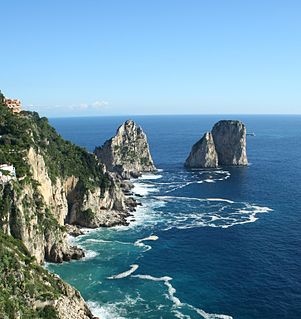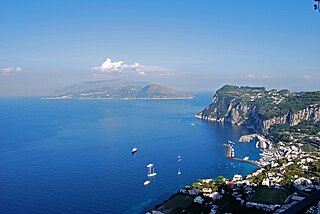
The Sorrento Peninsula or Sorrentine Peninsula is a peninsula located in southern Italy that separates the Gulf of Naples to the north from the Gulf of Salerno to the south.

The Province of Naples was a province in the Campania region of southern Italy; since January 2015 has been replaced by the Metropolitan City of Naples.

In Italian, faraglioni are stacks, a coastal and oceanic rock formation eroded by waves.

Parco Virgiliano is a scenic park located on the hill of Posillipo, Naples, Italy. The Park serves as a green oasis, built on the tufa stone typical to the coast of Posillipo.

Via Krupp is a historic switchback paved footpath on the island of Capri, connecting the Charterhouse of San Giacomo and the Gardens of Augustus area with Marina Piccola. Commissioned by German industrialist Friedrich Alfred Krupp, the path covers an elevation difference of about 100 m.

Marina Grande is the main port of the island of Capri in Italy, to the north of the main town of Capri and at the foot of Mount Solaro.

Marina Piccola is located on the southern side of the island of Capri. It is near the Faraglioni sea stacks to the southeast. The Via Krupp is a historic switchback paved footpath which connect the Charterhouse of San Giacomo and the Gardens of Augustus area with Marina Piccola. The Marina Piccola, used by Augustus and Tiberius, preceded the Marina Grande.
Palazzo a Mare is a well-preserved ancient Roman archaeological site on the north side of the island of Capri, consisting of an imperial palace built by Augustus and modified by Tiberius. It was one of the supposed 12 villas of Tiberius on the island as described by Tacitus along with the Villa Jovis, Villa di Gradola and Villa Damecuta. It covers a very large area on several terraces overlooking the sea.

The Gardens of Augustus, originally known by the name of Krupp Gardens, are botanical gardens on the island of Capri, Campania, Italy.

Piazza Umberto I is the most famous square of the island of Capri, Italy. The square is located in the historic center of Capri, in the eponymous town Capri, on the eastern end of the island, and since Roman times, it has been considered the center of the town and the meeting point of the island by both residents and others.

Santo Stefano is a Catholic church and former cathedral on the island of Capri, Italy. Dedicated to Saint Stephen, it is the principal house of worship in the town of Capri. The religious complex was built around the Piazza Umberto I square in the seventeenth century. The archbishop's palace is now used as the town hall ("Municipio"). Santo Stefano and Chiesa di San Costanzo are the island's two oldest churches.

Cimitero acattolico di Capri is a non-Catholic cemetery on the island of Capri. Established in 1878 by Englishman George Hayward, it contains 204 graves from a total of 21 different nations. Most of the people buried in the cemetery though are of English nationality, German, Russian or American. Aside from Protestants, also buried in the cemetery are Jews, Orthodox Christians and some Catholics. Notable interments include French Baron Jacques d'Adelsward-Fersen, Lucio Amelio, Günter Ammon, Gracie Fields, Norman Douglas and Jakob Johann von Uexküll.

Villa Certosella is a hotel in Capri, Italy. Set along the Via Tragara, it was the home of Camille du Locle when he lived in Capri. The villa was enlarged by the illustrator Jan Styka in Italian Renaissance style. Later, Edwin Cerio requisitioned the house so that it is now part of the Ignazio Cerio estate. Cerio removed the Renaissance elements, returning the house to the casa mediterranea style. The master builder, Luigi Desiderio, worked on the property.

The Chiesa di San Michele Arcangelo is located in Anacapri, Capri, Italy. Located on Piazza San Nicola and built in 1719, it is octagonal in shape and of Baroque style. The church received a "monument" designation due to its notable majolica floor mosaic.
The Villa Monacone is located on the island of Capri, Italy. Situated near Pizzolungo and the Faraglioni rocks, its name derives from its location, which faces the Faraglioni's Monacone rock formation. The architectural style is unusual for a Capri villa. Built into the mountain's rocky slope, the columns and cross vaults opening by the porch connects with interior rooms rather than with the kitchen, the more common layout for a Capri villa. The German novelist, Monika Mann, lived at Villa Monacone with her friend, Antonio Spadaro, from 1954 to 1986. The Romanian historian Mircea Eliade stayed at one time in an annex of the villa.
The Grotta del Pisco is a cave on the southwestern side of the island of Capri, Italy. Impasto ware fragments found at the Anacapri site are from the Copper Age. Gaudo culture artifacts were identified here and at the Grotta delle Felci.

The Chiesa di Santa Sofia is located in the Piazza of Anacapri, on the island of Capri, Italy. It dates to 1596 when it replaced Chiesa di Santa Maria di Costantinopoli as the parish church. Some of the building materials and fittings, such as the sacristy and oratorio, were originally in the Chiesa di San Carlo. The church chapels are dedicated to Sant'Antonio, Anacapri's patron saint, and the Madonna del Buon Consiglio. Architectural features include two bell towers and a baroque facade. The wedding of Guiliana DePandi and Bill Rancic occurred at the Chiesa di Santa Sofia.
Chiesa di Santa Maria di Costantinopoli is a church located in the Li Curti district of Anacapri, on the island of Capri, Italy. Built in the eleventh century and restored in the seventeenth century, its architectural features include Gothic and Byzantine elements. It contains several works by the Flemish painter Willem Borremans. At one time the parish church of Anacapri, the Chiesa di Santa Maria di Costantinopoli was replaced by the Chiesa di Santa Sofia in that role.
Chiesa di Santa Maria del Soccorso is located within the archaeological site of Villa Jovis, on the island of Capri, Italy. It is situated on the summit of the Lo Capo hill at the eastern extremity of the island. The chapel-like church, was constructed ca. 1610. Its fittings include a bronze statue of the Madonna, a 1979 gift of the Caprese painter Guido Odierna (1913-1991). In the late 19th century, hermit lived at the church, keeping a visitor's book and selling wine.
Chiesa di Sant'Andrea is a church on the island of Capri, Italy, near the Marina Piccola in the south. It was built in 1900 for the local fishermen. The site which the church lies on formerly contained a watch tower which was used as a lookout post for invading Saracen pirates. The church was designed by the painter Riccardo Fainardi, and funded by German banker Hugo Andreae and his wife, Emma.



















